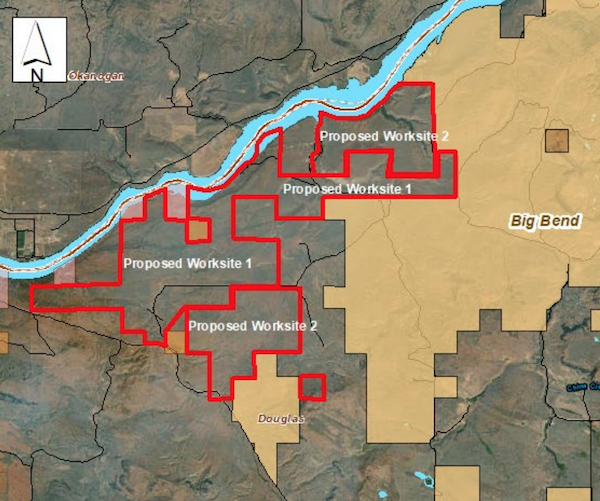
Open Comment On WDFW Buying Up To 12,500 Acres For Habitat, Rec
Public comment is now being taken on more than a dozen potential WDFW land acquisitions across Washington that would enhance fishing and hunting access and benefit fish and wildlife and their habitats.
The lands range from up to 5.4 square miles next door to the newer Big Bend Wildlife Area in northern Douglas County to 38 acres on a bend of the lower Sol Duc to tidelands and estuaries on Puget Sound and Hood Canal.

All totaled, the 15 projects encompass around 12,500 acres and are spread across 14 counties.
They’ve been initially vetted through WDFW’s Lands 20/20 initiative, which the agency describes as a “rigorous review process [that] considers species and habitat management plans, regional conservation initiatives, community perspectives, and outdoor recreation.”
“Public input is at the core of how we make decisions about acquiring new public land in line with our goals for conservation and outdoor recreation,” said Cynthia Wilkerson, WDFW Lands Division manager, in a press release. “We take our obligation to fully consider the perspectives related to potential new land management obligations seriously, and your input is a key element.”
If Director Kelly Susewind greenlights staffers to seek funding, the projects will need to compete for federal grants awarded for habitat work benefitting threatened critters or dollars from the state legislature dedicated to fish and wildlife habitat and public recreation.
Then they need to be officially purchased by the Fish and Wildlife Commission. It’s a process that can take years upon years for larger, more complex multiphase deals.

Six of the proposed projects are located in Central Washington – where WDFW has for decades worked to preserve habitat, and big chunks of it – and would directly benefit hunters, game and nongame species, and unique landscapes alike. They include acquiring:
- 479 acres on and above Blue Lake west of Oroville for shrubsteppe conservation and mule deer hunting;
- a 3.4-acre inholding of the Texas Creek Unit of the Methow Wildlife Area near Carlton;
- As many as 3,425 acres as phase four of the Big Bend project to protect and restore sharp-tailed grouse habitat, and provide mule deer, upland bird and turkey hunting opportunities and shoreline access to nearly 2 miles of the Upper Columbia in Douglas County;
- 23 acres from WashDOT adjacent to a planned 240-foot-wide wildlife crossing of I-90 near Easton in Kittitas County and that would benefit elk, deer, carnivores and other species;
- 440 acres next to WDFW lands and leases in the Wenas Creek watershed of Yakima County to preserve elk winter range and shrubsteppe habitat;
- and up to 260 acres on the Klickitat River and adjacent to the Soda Springs Unit of the Klickitat Wildlife Area to preserve intact riparian zones and provide fishing and hunting access.
In the state’s southeast corner is a 285-acre parcel bordering the WT Wooten Wildlife Area on three sides and described as a “critical calving area” for the hard-bitten Blue Mountains elk herd.
But the largest proposal is actually in Western Washington, up to 7,300 acres on the upland side of the existing Hoffstadt Unit of the Mt. St. Helens Wildlife Area on the North Fork Toutle River to improve elk winter range and steelhead and coho waters.
“This is essential for landscape-level conservation of the elk herd in the face of continual habitat
inundation due to efforts necessary to hold back sediment from the Mt. St. Helen’s eruption,” WDFW explains. “The property contains 17 miles of stream and riparian habitat that sustains important tributary and habitat functions. Along with streams and riparian, the property also features cliffs, talus slopes, and forest.”

Not far to the south is a 90-acre parcel next to the Shillapoo Wildlife Area by Vancouver that offers a chance to restore riparian habitat for salmon and contiguously manage a wetland complex.
Then there are intertidal opportunities in Jefferson, Mason and Snohomish Counties that would improve connectivity to existing WDFW-owned parcels for shellfish harvesting and estuarine habitat work.
Other proposals geared toward better angler access to the water include:
- an acre along the Grande Ronde across from Boggan’s Oasis, building on an existing recreation site by the Highway 129 bridge;
- 38 acres on the Sol Duc off Highway 101 just north of Forks to replace a nearby site washed away by shifting flows and which would provide “nearly 1,500 feet of easily accessible fishing” access to the steelhead-, Chinook- and coho-bearing river. The land currently appears to be a private campground;
- and a donation of an acre-sized inholding at WDFW’s South Montesano Access on the lower Chehalis.
This is the first slate of possible acquisitions WDFW has sent out for comment since early 2021. One from that year, the purchase and donation of TransAlta’s 15-square-mile Chehalis mine, proved to be a little tougher to swallow locally and with some members of the Fish and Wildlife Commission and so the project was set aside for the time being.
Comment on this latest batch runs through November 21 – email lands@dfw.wa.gov or mail comments to Wildlife Program, Washington Department of Fish and Wildlife, PO Box 43200, Olympia, WA 98504 – and the commission will be briefed at its December 8-10 meeting in Clarkston.
